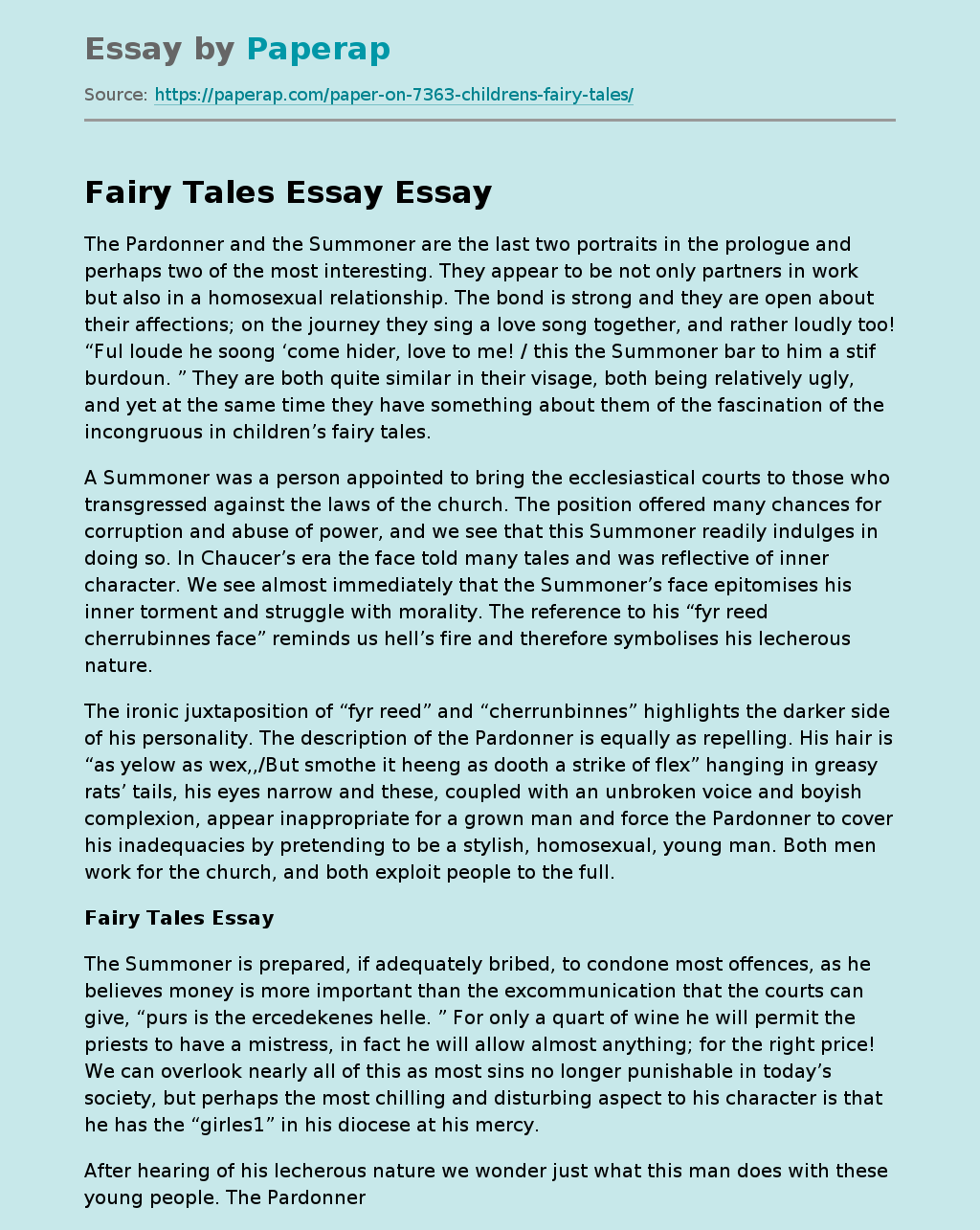The Canterbury Tales: The Summoner and the Pardoner
The following sample essay focuses on The Canterbury Tales: The Summoner and the Pardoner. Read the introduction, body and conclusion of the essay, scroll down.
The Pardonner and the Summoner are the last two portraits in the prologue and perhaps two of the most interesting. They appear to be not only partners in work but also in a homosexual relationship. The bond is strong and they are open about their affections; on the journey they sing a love song together, and rather loudly too! “Ful loude he soong ‘come hider, love to me! / this the Summoner bar to him a stif burdoun.
” They are both quite similar in their visage, both being relatively ugly, and yet at the same time they have something about them of the fascination of the incongruous in children’s fairy tales.
A Summoner was a person appointed to bring the ecclesiastical courts to those who transgressed against the laws of the church. The position offered many chances for corruption and abuse of power, and we see that this Summoner readily indulges in doing so.
In Chaucer’s era the face told many tales and was reflective of inner character. We see almost immediately that the Summoner’s face epitomises his inner torment and struggle with morality. The reference to his “fyr reed cherrubinnes face” reminds us hell’s fire and therefore symbolises his lecherous nature.
The ironic juxtaposition of “fyr reed” and “cherrunbinnes” highlights the darker side of his personality. The description of the Pardonner is equally as repelling.
His hair is “as yelow as wex,,/But smothe it heeng as dooth a strike of flex” hanging in greasy rats’ tails, his eyes narrow and these, coupled with an unbroken voice and boyish complexion, appear inappropriate for a grown man and force the Pardonner to cover his inadequacies by pretending to be a stylish, homosexual, young man. Both men work for the church, and both exploit people to the full.
Fairy Tales
The Summoner is prepared, if adequately bribed, to condone most offences, as he believes money is more important than the excommunication that the courts can give, “purs is the ercedekenes helle. ” For only a quart of wine he will permit the priests to have a mistress, in fact he will allow almost anything; for the right price! We can overlook nearly all of this as most sins no longer punishable in today’s society, but perhaps the most chilling and disturbing aspect to his character is that he has the “girles1” in his diocese at his mercy.
After hearing of his lecherous nature we wonder just what this man does with these young people. The Pardonner, like the Summoner, earns his living through deceiving people. Pardonners were sellers of Papal indulgences, whereby a sinner could buy penance; but this Pardonner earns extra money to that which he gains selling penances; he sells “relikes. ” A “pilwe-beer” which he claims is the veil of the Virgin Mary, “pigges bones” masquerading as those of a saint, fragments of the sail and a cheap cross and with these and “feyened flaterie and japes,/ He made the person and the people his apes.
” Perhaps, howver, the ultimate irony is that this loathsome creature is extremely convincing in church “But trewely to tellen at laste,/ he was in chirche a noble ecclesiate. ” In writing the portrait of the Summoner, Chaucer appears to be flattering the man when he is in fact his scathing satire is reaching new intensities. When describing the Pardonner, on the other hand, Chaucer is openly hostile. One source claims that this si so that we can empathise with his “spiritual sterility”, but in my opinion Chaucer merely created a character to be totally loathed and detested.
The Friar is third ecclesiast in the prologue and the last of the trio of deviants who set their desires against the ordained patterns of behaviour. Of all of them, the Friar is by far the worst. This Friar, like others, has moved form being an itinerant teacher and defender of the faith, to being an exploiter of the poor and a parasite on the community. Perhaps Chaucer was trying to warn us when he opened the portrait by describing the Friar as ” a wantowne and a merie,/ A limatour, a ful solempne man.
” These adjectives seem to have been randomly thrown together by Chaucer and in fact this sort of moral chaos is perfectly fitting for the Friar. “He hadde maad ful many a marriage/ Of yonge wommen at his owene cost. ” This altruistic gesture seems more in keeping with the duties of a devoted Friar, but I discovering his lecherous nature the gesture begs the question why? The Friar is not selfless and we wonder what was in it for him? It becomes apparent that these marriages are merely a despicable front, a way of offloading his own sexual mistakes and a means of allowing him to negate responsibility for his actions.
“Unto his ordre he was a noble post,” This is heavily ironic as we find it hard to conceive that this man is the pillar of any community. Chaucer’s use of adverbs such as “sweetly” and “plesaunt” only serve to highlight the sarcastic and ironic tone of this portrait. The Friar abuses his power of confession “He was an esy man to yeve penaunce, /Ther as he wiste to have a good pitaunce” which is a great contrast to the Parson who would “snibben sharply for the nonis” any man who transgressed, regardless of his social position.
The Canterbury Tales: The Summoner and the Pardoner. (2019, Dec 05). Retrieved from https://paperap.com/paper-on-7363-childrens-fairy-tales/

